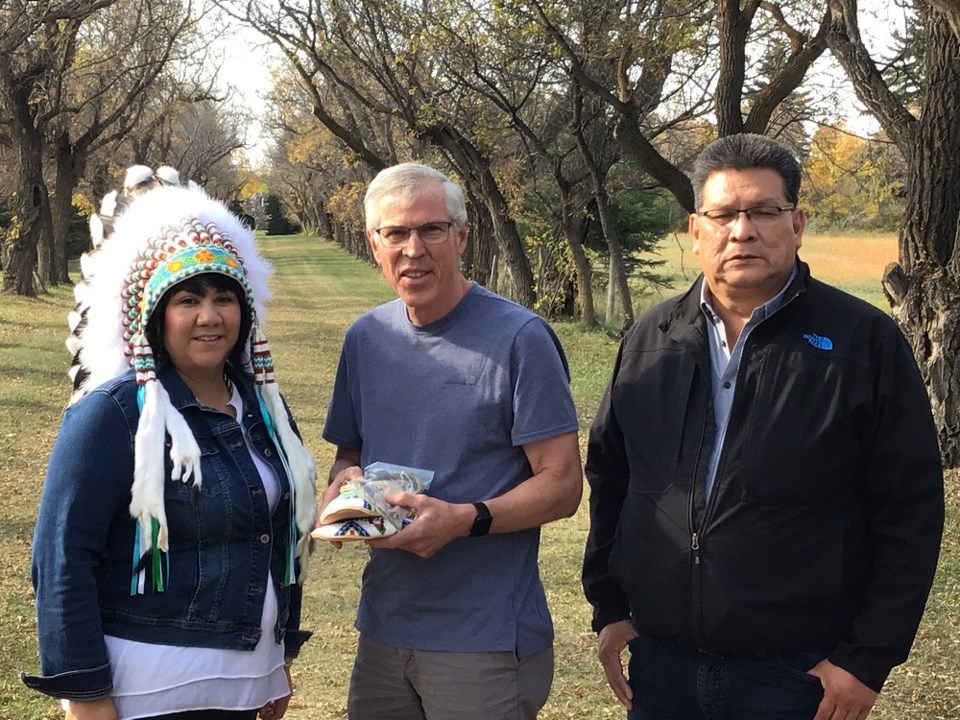BATTLEFORD - The efforts by local individuals to better understand the history of Battleford and Saskatchewan got a boost this past week.
Bill Waiser, professor emeritus from the University of Saskatchewan who is now a full time author and public speaker, was up at The Ridge to visit with their study group, who have been meeting weekly to focus on the history of Indigenous and non-Indigenous relations in the region.
Waiser was there at the invitation of Grant Beaudry, CEO of Mosquito Grizzly Bear’s Head Lean Man (MGBHLM) Economic Development. Among those at the study group was Chief Tanya Stone of MGBHLM First Nation. MGBHLM purchased The Ridge from the Oblates last year and is in the process of turning it into a wellness, business and tourism hub that could include an art gallery and cultural centre.
The topics the group covered at the meeting were wide ranging, but Waiser said it started with a discussion of truth and reconciliation.
“We need to know what happened in the past with respect to Indigenous and non-Indigenous relations, why it happened in that particular way. And then you need to bring that understanding to the situation today, how we got to where we are, and bring that knowledge and bring that understanding to talk about some of the challenges we face today and what can be done to move forward,” said Waiser.
This particular visit to The Ridge was the first in quite a while for Weiser. The last time he was there was back when Government House was still standing, he said.
He had spent plenty of time in the Battlefords researching his previous books. Waiser is the author of 19 books, many of which deal with Indigenous and non-Indigenous relations.
His work included a book produced in 1997 with Blair Stonechild, called Loyal Till Death: Indians and the Northwest Rebellion, which looked at 1885 from the First Nations point of view.
In 2005 he wrote a provincial history for the Saskatchewan Centennial titled Saskatchewan: a New History.
“First Nations and Indigenous history is a large part of that story. I don’t bookend it — you don’t meet First Nations at the beginning and the end, they’re throughout the story because they’re an essential part of Saskatchewan history,” said Waiser.
He also wrote A World We Have Lost, about the history before Saskatchewan became a province. More recently he wrote History Matters and History Matters 2, which were a collection of his history columns that had run in the Star-Phoenix.
Waiser provided the books to the study group to help them along in their research efforts.
The study group had developed a chart that served as a timeline with important points noted in history. It included key moments such as the loss of the buffalo, the Second World War, and the dates the residential schools operated.
They talked about Battleford and its place as a Territorial capital, as well as the 1885 rebellion and post-rebellion period. Waiser explains 1885 was a particular turning point.
“It was a key turning turning point in the history of this region, in part because after 1885 many bands are declared disloyal — they were considered rebel bands after 1885. The Department of Indian Affairs after 1885 takes a very hard line with regard to its relationship with Indigenous people in this region and throughout western Canada. You’ve got the introduction of the pass system, you’ve got the permit system which limits what they can market, what produce they can market and when and how. You've got the introduction of a peasant farming policy where First Nations bands could only use hand tools instead of the new modern machinery. You’ve got the banning of traditional spiritual practices. So it’s a very heavy hand after 1885. And there’s also that feeling after 1885 that the non-Indigenous community viewed the Indigenous community as a group they could not trust any longer, and relations between the two groups soured after 1885. And that’s why it was a key turning point in the history of this region.”
The emphasis of his meeting at The Ridge, Weiser said, was that they needed to work together and build relationships and trust between Indigenous and non-Indigenous people.
The key from that day’s meeting, Waiser said, is “we’re all in this together. We need to understand our history, and use our understanding of history to deal with the challenges that we face today and move forward together.”





